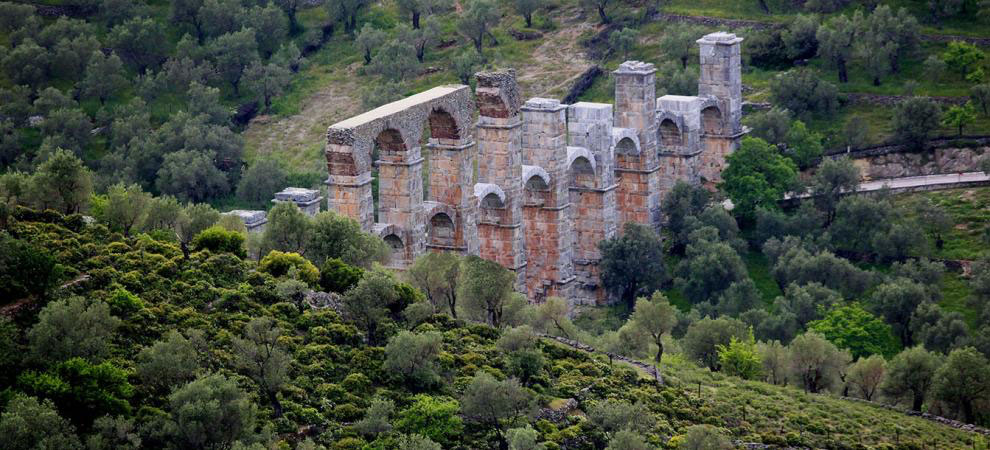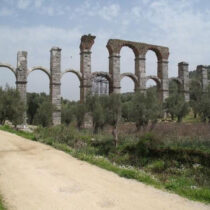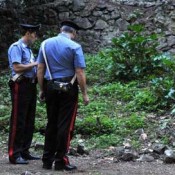The recent cold front “Medea” brought to light serious problems threatening the stability of the monument. During the extreme weather the scaffolding collapsed that supported the arch of the middle tier of the Roman aqueduct in Moria, Lesvos, which was already facing the great problem of loose masonry.
Between 2001-2004, sections of arches near collapse and their corresponding pillars were fixed and partially rebuilt, out of the monument’s 17 in all arched openings which showed deformations. The aqueduct has been abandoned since 2004-2005, when money ran out for the first phase of the stabilizing, restoration and reconstruction works on the Roman monument, while only the arch with loose masonry was supported.Since then, the continuation of the work has not been included in any financial programme by the Directorate for the Restoration of Ancient Monuments of the Ministry of Culture.
Fifteen years later, the iron support scaffolding collapsed during the recent cold front , revealing serious problems. The “keystone” has slipped in the arch being supported, making a collapse imminent. This creates the risk of a large part of the monument collapsing as the arch tier supports its entirety.
The aqueduct of Moria was made up of three tiers of arches. The upper tier which included the water conduit has 17 arches. With the destruction of the pipeline, most of its brick arches fell, and in the case of the remaining ones, their structure loosened following the erosion and disintegration of the masonry. Some stone arches of the middle tier have collapsed, while the remaining ones have loose masonry
The existing published study of the unfinished project foresees the increase of the mechanical characteristics of the pillars’ natural stone, the maintenance and reconstruction of the arches whose keystones have slipped and lastly the supplementing of those stone arches of the middle tier that have collapsed.
The monument’s history
In Roman times the city of Mytilene was considered by writers of the period as one of the most beautiful cities of the eastern part of the empire, along with Rhodes and Ephesus. The city’s increased need for water was met by the Roman aqueduct, a large technical project that transported water from the springs of the Olympus mountain range to the eastern side of the island, where the city of Mytilene was built.
In order to support the central aqueduct and to ensure the proper gradient, the architect of the Mytilene aqueduct constructed single-arched aqueducts at Aneraida, Kousteri and Paspala, two-arched ones at Kamaroudia and Koutsouk Loutsa, four arched ones near Paspala, possibly at Vrysouda and Thyridia and the aqueduct with tiered arches in Moria.
The Moria aqueduct has a length of 170 m. and a maximum surviving height of 24.46 m. in the center of the valley. It is the most important part of the Roman aqueduct and perhaps the most prominent monument of rural Lesbos. It comprises 17 arched openings and 3 consecutive tiers of arches in the central part, built with the help of 16 pillars. Of the original pillars the central ones are better preserved in our time, while only the lower parts of the end pillars have survived. The Moria aqueduct is undoubtedly one of the most beautiful in the ancient world due to its particular architectural design, transforming it from a large-scale utility technical work to a exceptional work of architecture. According to Ioannis Kontis, “the whole construction looked like a single building facade with three consecutive galleries”.
It is thought that the aqueduct route terminated within the city walls below the “Tekke” of the ancient theatre, although further research is needed to accurately calculate the location of the reservoir for gathering and distributing the water to baths, cisterns, fountains and luxurious private residences.
We do not have any direct information from ancient sources about the architect and the aqueduct’s construction. Of the aqueducts of the ancient world, the closest in construction to the aqueduct of Mytilene, with similarities in the structure of the pillars and arches, is the aqueduct of the ancient city of Side and Antioch of Pisidia.
Taking into account the construction details and the historical context, modern research considers that the aqueduct of Mytilene should be dated at least to the second half of the 2nd century AD.




